One of the great stately homes of England, set in a broad estate dotted with monuments and other buildings.
Most of it was built between 1699 and 1712 for the 3rd Earl of Carlisle, to a design by Sir John Vanbrugh. The south or garden front has two wings on either side of a central hall and dome. The house was badly damaged by a fire in 1940, which destroyed the dome and twenty rooms. Some rooms have been restored over the decades, but the east wing remains a shell.
Today the house contains many treasures, including several important collections of pictures, porcelain, sculpture, an enormous wine cooler, and the William Morris screens.
Castle Howard’s other claim to fame is that it was used as the location for the fictional “Brideshead Revisited” TV series. Some fire-damaged rooms were part-restored for use as sets, and others were restored with TV money. An exhibition about the filming can be seen in the house.
Outside there are gardens, and a number of listed monuments, including the Temple of the Four Winds, the Mausoleum, and numerous statues. There is also a huge lake.
There is enough to see and do to occupy the visitor for much of the day. If you want to see the monuments it helps if you like walking.
Byland Abbey, Yorks.
English Heritage
Impressive ruins remain of what was once a great Cistertcan abbey. Much of the layout of the cathedral-sized church survives, and the skyline is etched by the outline of a great ruined rose window, similar to that at York Minster. On the site there is now a museum with interpretation panels, and relics from the site.
Beningborough Hall, Yorkshire
The great baroque house was built in the early 18th century. Notable are long vistas down the corridors, and the high quality of woodcarving on friezes and overmantels. The contents were dispersed in a 1958 sale, but some have been bought back since. The house also hosts a loan of 120 portraits from the National Portrait Gallery, and some porcelain from the Ashmolean Museum. Outside, a garden lies along the south side of the house.
Belton House, Lincs
National Trust
An H-shaped house built in the reign of Charles II (1685-7) sits in a wooded park, with gardens. The interior furnishings and fittings are of high quality and include collections of silver and porcelain. Delicate and intricate woodcarvings surround pictures and frame doors, and there are superb plaster ceilings in several of the principal rooms. Nineteenth-century formal gardens are laid out to the north of the house. The well-known architect James Wyatt carried out alterations to four principal rooms, and the exterior, in the late 18th century.
All photos were taken during my second visit in Sept 2022. It was raining so I was not able to visit the gardens.
The house and grounds are impressive and well worth a visit.

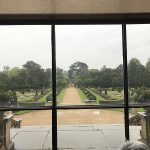

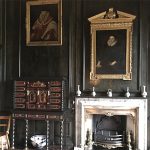
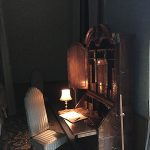
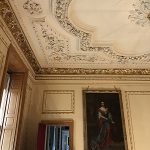
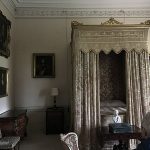
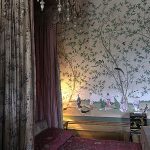
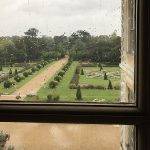
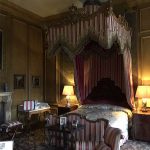
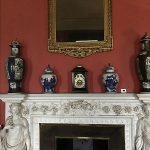
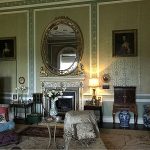
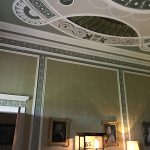
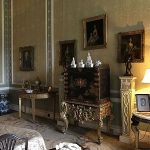
Barrington Court, Somerset
National Trust
This mid-sixteenth century house has a spiky outline of gables and chimneys and is built to a characteristic Elizabethan E-plan. Barrington was the first country house to be acquired by the National Trust, and it could be said that the NT has learnt by its mistakes. Ever since, the NT has been wary of accepting a house without a substantial endowment to provide for its upkeep. Barrington came to the NT as a derelict gutted shell with few original internal features remaining. Its present authentic-looking internal appearance is due to the sympathetic attention of an early tenant, Colonel A Lyle (of sugar fame) who lined it with his collection of interior fittings salvaged from contemporary derelict buildings. Every house seller knows that a house looks better with the rooms kitted out with furniture and fittings, and today Barrington is leased to Stuart Interiors for the display of period and reproduction fine furniture.
Today, the rooms, including the gallery on the top floor, make an interesting visit. The house exterior is attractive, and surrounded by lawns, a partial moat and gardens.
Yorkshire Air Museum
The Yorkshire Air Museum, situated on a former WWII bomber base at Elvington, lays claim to be the largest independent air museum in Britain. It features 15 exhibitions, 50 aircraft, many of them in working order, and a large range of military vehicles. Also commemorated is the wartime presence of two French heavy bomber squadrons – the only two to operate from Britain. Aircraft in the collection range from WWI replicas to a Nimrod. Airplane buffs should allow at least half a day for a visit.
York Railway Museum
Also known as the National Railway Museum, York.
For a train buff, heaven would probably consist of a day here, plus a ride on a steam-hauled mainline excursion train. There are about 100 locos, 200 other items of rolling stock, and hundreds of thousands of other objects, everything from rubber handstamps to turbine powered railcars.
The museum has free admission, and is a couple of minutes’ walk from the York mainline rail station. It’s possible to walk to the museum from anywhere in York town centre in about 10 mins. There is a car park in Leeman Road adjacent to the Museum. If you think the daily parking charges are a bit much, you could take a bus from your accomodation to the centre of York, or use the ring-road park and ride from Rawcliffe Bar or Askham Bar, from where services 2 and 3 should drop you outside the museum. Central York during the day is not a place you want to be if you are a car driver. (I was staying in the suburbs of York and came in by bus).
BTW, there is another branch of the NRM at Shildon, Co. Durham. The collection there includes the Advanced Passenger Train.
Lynton and Barnstaple Railway
This is a narrow-gauge railway, re-created over part of an old route near Exmoor. The route is quite short, and once you’ve ridden the train and had tea there probably isn’t a lot else to do. The rolling stock includes two small steam locos and one diesel. Worth a visit when combined with other attractions in the same area.
Chinnor and Princes Risborough Railway
This is one of the more minor preserved railways. Three and a half miles of track runs from Chinnor (the only station) to Thame Junction, in the direction of Princes Risborough. Sunday is the principal operating day, and some trains are steam hauled. Curiously there are no steam locos on the stock list, but they have a 0-6-2 tank on loan (Sept 2011).
Worth a visit if you are nearby visiting other attractions in the area. Once you have ridden on the train there isn’t much to do except ride on it again.
Severn Valley Railway
This preserved steam railway runs from Bridgnorth to Kidderminster. There are 6 stations and about 16 miles of track. It recreates the feel of railway travel of a past era quite well. The line has been prone to landslips, and if I remember correctly, there were places where the train trundled slowly past the greenery and one could see trackside fittings that had obviouly moved several feet laterally. Near the tracks there are various things to look at, including The Engine House, a new museum and visitor centre, and touristy stuff in the towns along the line. The line now carries around 250,000 passengers annually. At one time there was an annual folk festival at Bridnorth, and they had a Folk Train excursion to pubs with folk music sessions in a couple of picturesque towns down the line. We got to play music on the train too. You could have a similar inebriated outing – just leave out the folk music.
